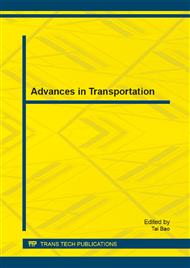p.999
p.1005
p.1014
p.1023
p.1028
p.1037
p.1041
p.1046
p.1055
A Study of an Adaptive Two-Phrase Signal Control Strategy for Resolving Conflicting Transit Signal Priority Calls
Abstract:
This paper presents the development and evaluation of an adaptive two-phrase signal control strategy to resolve conflicting Transit Signal Priority (TSP) requests. The strategy was designed to provide adaptive transit signal priority control, using vehicle systems and existing traffic control devices. In this paper, the strategys efficiency was tested using a micro-simulation software VISSIM and build one arterial road contains five intersections and serves more than twenty conflicting bus lines. The VAP module was used to control TSP of conflicting requests. In the simulation, actual data was used. Finally, control efficiency about adaptive signal control strategy is discussed. The results show that the presented strategy can improve the operation efficiency of bus corporations. This signal control strategy reduced the travel delay time by 33 % to 55% of transit, while has little impact on private traffic. The strategy shows promising results. In addition, with minor upgrades, it can be applied to any type of intersection.
Info:
Periodical:
Pages:
1028-1036
Citation:
Online since:
January 2014
Authors:
Price:
Сopyright:
© 2014 Trans Tech Publications Ltd. All Rights Reserved
Share:
Citation:


